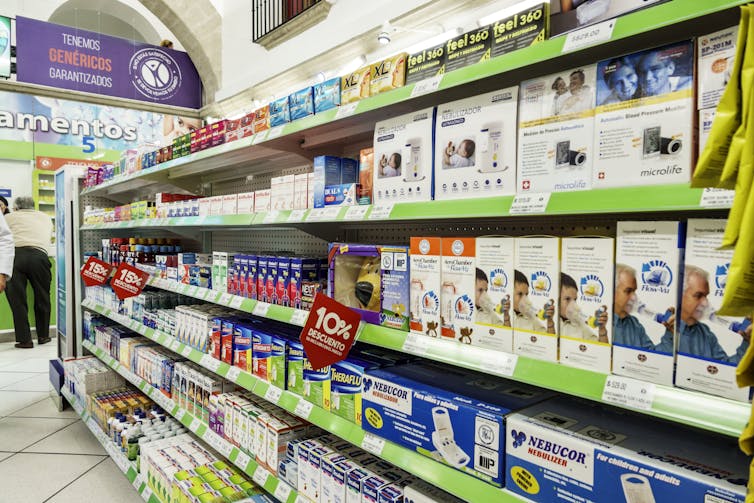Ana Santos Rutschman, Professor of Law, Villanova School of Law
The price of asthma medication has soared in the U.S. over the past decade and a half.
The jump – in some cases from around a little over US$10 to almost $100 for an inhaler – has meant that patients in need of asthma-related products often struggle to buy them. Others simply can’t afford them.
To make matters worse, asthma disproportionately affects lower-income patients. Black, Hispanic and Indigenous communities have the highest asthma rates. They also shoulder the heaviest burden of asthma-related deaths and hospitalizations. Climate change will likely worsen asthma rates and, consequently, these disparities.
I’m a health law professor at Villanova University, where I study whether patients can get the medicines they need. And I’ve been watching this affordability crisis closely.
In many ways, it shows what happens when law and policy decisions aren’t aligned with public health needs. The good news, however, is that there finally seems to be some political will to rein in the price of asthma meds.
Why inhaler prices are skyrocketing
In 2008, the U.S. Food and Drug Administration banned inhalers that use chlorofluorocarbons, or CFCs – which were once widely used as propellants – because they can damage the ozone layer. The FDA was following a timeline set by an environmental treaty, the Montreal Protocol, which the U.S. ratified in the late 1980s.
From 2009 onward, CFC inhalers were phased out and replaced with hydrofluoroalkane, or HFA, ones, which are more environmentally friendly. They’re also a lot pricier. For patients with insurance, the average out-of-pocket cost of an inhaler rose from $13.60 per prescription in 2004 to $25 immediately after the 2008 ban, a 2015 study found.
Today, the average retail price of an albuterol inhaler is $98. Unlike CFC inhalers, which have generic versions, HFA inhalers are covered by patents. While the drug itself hasn’t changed, the switch to a different device allowed companies to increase their prices.
In 2020, the FDA finally approved the first generic version of an albuterol inhaler. But generic competition still isn’t robust enough to lower prices meaningfully.
Patients with good insurance may pay very little or even nothing. But uninsured patients face steep market prices, and as of 2023, there were over 25 million uninsured Americans. Even insured patients may have trouble affording their asthma meds, the CDC has found.
The same asthma medication for which U.S. patients pay top dollar is available elsewhere at much cheaper prices. Consider the following case for inhalers. The pharmaceutical company Teva sells QVAR RediHaler, a corticosteroid inhaler, for $286 in the U.S.
In Germany, Teva sells that same inhaler for $9.
Seeking meds from Mexico and Canada
Some U.S. patients have traveled abroad to obtain cheaper asthma medication. After the 2008 ban on CFCs, it became common for patients to visit border towns in Mexico to purchase albuterol inhalers. They were sold for as little as $3 to $5.
A study of inhalers available to U.S. patients in Nogales, Mexico – about an hour south of Tucson, Arizona – found that Mexican products were generally comparable to U.S. inhalers. But researchers found some differences in performance, suggesting that American patients who use them could be getting a slightly different dose than their usual.

There have also been reports of Americans turning to Canadian pharmacies to purchase asthma inhalers at much cheaper prices. In one case, a U.S. pharmacy would have charged $857 for a three-month supply. A patient obtained it for $134 from a pharmacy in Canada.
One potential fix: Importing cheaper meds
U.S. law has long prohibited personal importation of pharmaceutical drugs. However, a recent development could pave the way for states to import cheaper asthma drugs.
In January 2024, the FDA authorized the importation of certain prescription drugs from Canada for the first time. For now, this authorization is limited to Florida, and it covers only drugs for HIV/AIDS, prostate cancer and certain mental health conditions.
Should it prove successful, the program could serve as a blueprint for other states.
Another possible solution: Price-capping
Policymakers could also try borrowing a page from the insulin playbook. Insulin prices climbed for almost two decades before Congress acted, capping the cost of insulin for Medicare patients. The 2022 Inflation Reduction Act established an out-of-pocket ceiling of $35 per month for prescription-covered insulin products.
If this cap had been in effect two years earlier, it would have saved 1.5 million Medicare patients about $500 annually, a recent study estimated. It also would have saved Medicare $761 million.
A similar approach could be taken for asthma meds.
Congress could create an asthma-specific rule similar to the insulin case. Or it could place provisions for asthma-med prices into a larger piece of legislation.
While this approach depends on the political environment, there are signs the government is becoming more willing to act. In January 2024, the U.S. Department of Health and Human Services hosted a meeting to discuss the problem with manufacturers and other stakeholders.
It’s a start. And – together with other measures – it brings some hope that asthma meds might soon become more affordable to those in need.
This article is republished from The Conversation under a Creative Commons license. Read the original article.






